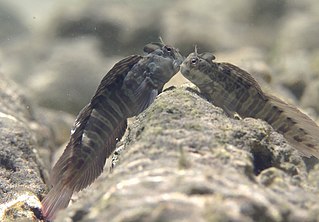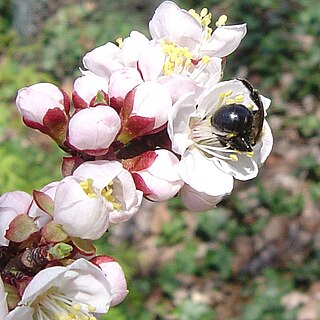
The International Union for Conservation of Nature (IUCN) Red List of Threatened Species, also known as the IUCN Red List or Red Data Book, founded in 1964, is an inventory of the global conservation status and extinction risk of biological species. A series of Regional Red Lists, which assess the risk of extinction to species within a political management unit, are also produced by countries and organizations.

The Hawaiian crow or ʻalalā is a species of bird in the crow family, Corvidae, that is currently extinct in the wild, though reintroduction programs are underway. It is about the size of the carrion crow at 48–50 cm (19–20 in) in length, but with more rounded wings and a much thicker bill. It has soft, brownish-black plumage and long, bristly throat feathers; the feet, legs, and bill are black. Today, the Hawaiian crow is considered the most endangered of the family Corvidae. They are recorded to have lived up to 18 years in the wild, and 28 years in captivity. Some Native Hawaiians consider the Hawaiian crow an ʻaumakua.

The conservation status of a group of organisms indicates whether the group still exists and how likely the group is to become extinct in the near future. Many factors are taken into account when assessing conservation status: not simply the number of individuals remaining, but the overall increase or decrease in the population over time, breeding success rates, and known threats. Various systems of conservation status are in use at international, multi-country, national and local levels, as well as for consumer use such as sustainable seafood advisory lists and certification. The two international systems are by the International Union for Conservation of Nature (IUCN) and The Convention on International Trade in Endangered Species of Wild Fauna and Flora (CITES).

Fowlpox is the worldwide disease of poultry caused by viruses of the family Poxviridae and the genus Avipoxvirus. The viruses causing fowlpox are distinct from one another but antigenically similar, possible hosts including chickens, turkeys, quail, canaries, pigeons, and many other species of birds. There are two forms of the disease. The first is spread by biting insects and wound contamination, and causes lesions on the comb, wattles, and beak. Birds affected by this form usually recover within a few weeks. The second is contracted by inhalation or ingestion of the virus via dust or aerosols, leading to the 'diphtheritic form' of the disease, in which diphtheritic membranes form in the mouth, pharynx, larynx, and sometimes the trachea. The prognosis for this form is poor.

Blenniella gibbifrons, also known as the hump-headed blenny, bullethead rockskipper or picture rockskipper, is a species of combtooth blenny found in coral reefs in the Pacific and Indian Oceans from East Africa in the west to the Hawaiian, Line and Ducie Islands, in the east and north to Marcus Island.

Istiblennius is a genus of combtooth blennies found in the Pacific and Indian Oceans. The generic name is a compound noun composed of istio the Greek for "sail", referring to the high dorsal fin of the type species, Istiblennius muelleri, and blennius which is derived from a word for "mucus" and refers to the scaleless bodies that characterise the Blenniidae.

Istiblennius bellus, the imspringer, is a species of combtooth blenny found in coral reefs in the Pacific and western Indian Ocean. It is also known as the beautiful rockskipper or the dusky blenny. Males of this species can reach a maximum of 16 cm (6.3 in) SL, while females reach a maximum of 13.1 cm (5.2 in) SL.

Istiblennius edentulus, the rippled rockskipper, is a species of combtooth blenny found in coral reefs in the Pacific and Indian Oceans. It is also commonly known as the rippled blenny, smooth-lipped blenny, toothless blenny, or coral blenny. Males of this species can reach a maximum of 16 cm (6.3 in) TL, while females can reach a maximum of 13.2 cm (5.2 in) SL.
Istiblennius flaviumbrinus is a species of combtooth blenny found in the western Indian Ocean, specifically the Red Sea. Males of this species can reach a maximum of 9 cm (3.5 in) SL, while females can reach a maximum of 7.2 cm (2.8 in) SL.

Istiblennius lineatus, the lined rockskipper, is a species of combtooth blenny found in coral reefs in the Pacific and Indian oceans. It is also commonly known as the lined blenny, black-lined blenny, or thin-lined rockskipper. It can reach a maximum of 15 cm (5.9 in) TL. This species can be found in the aquarium trade.

Istiblennius meleagris, the peacock rockskipper, is a species of combtooth blenny found in coral reefs in the western Pacific ocean. It is also known as the white-speckled blenny. Males can reach a maximum of 15 cm (5.9 in) TL, while females can reach a maximum of 10.6 cm (4.2 in) SL.
Istiblennius muelleri, Mueller's rockskipper, is a species of combtooth blenny found in the western Pacific ocean. Males of this species can reach a maximum of 7 cm (2.8 in) SL, while females can reach a maximum of 5.5 cm (2.2 in) SL. The specific zoology honours the German-Australian physician, geographer, and botanist Ferdinand von Mueller (1825-1896).
Istiblennius rivulatus is a species of combtooth blenny found on coral reefs in the western Indian Ocean. Males of this species can reach a maximum of 8.6 cm (3.4 in) in standard length, while females can reach a maximum of 9.3 cm (3.7 in) in standard length.

Istiblennius spilotus, the spotted rockskipper, is a species of combtooth blenny found in the western Indian Ocean. Males of this species can reach a maximum of 14 cm (5.5 in) TL, while females can reach a maximum length of 9.7 cm (3.8 in) SL.
Istiblennius steindachneri is a species of combtooth blenny found in the western Indian Ocean. It can reach a maximum of 11 cm (4.3 in) in SL. The identity of the person honoured in this blenny's specific name was not stated by Pfeffer in his description but it is almost certainly the Austrian ichthyologist Franz Steindachner (1834-1919).

Istiblennius unicolor, the pallid rockskipper, is a species of combtooth blenny found on coral reefs in the western Indian Ocean. Males of this species can reach a maximum standard length of 10.2 cm (4.0 in), while females can reach a maximum length of 9.2 cm (3.6 in).

Istiblennius zebra, Pāoʻo, the zebra blenny, is a species of combtooth blenny found in tide pools around the Hawaiian Islands. It is also commonly known as the zebra rockskipper, rockskipper, jumping jack or the gori.

Prunus mandshurica, also called Manchurian apricot and scout apricot, is a tree in the genus Prunus.














